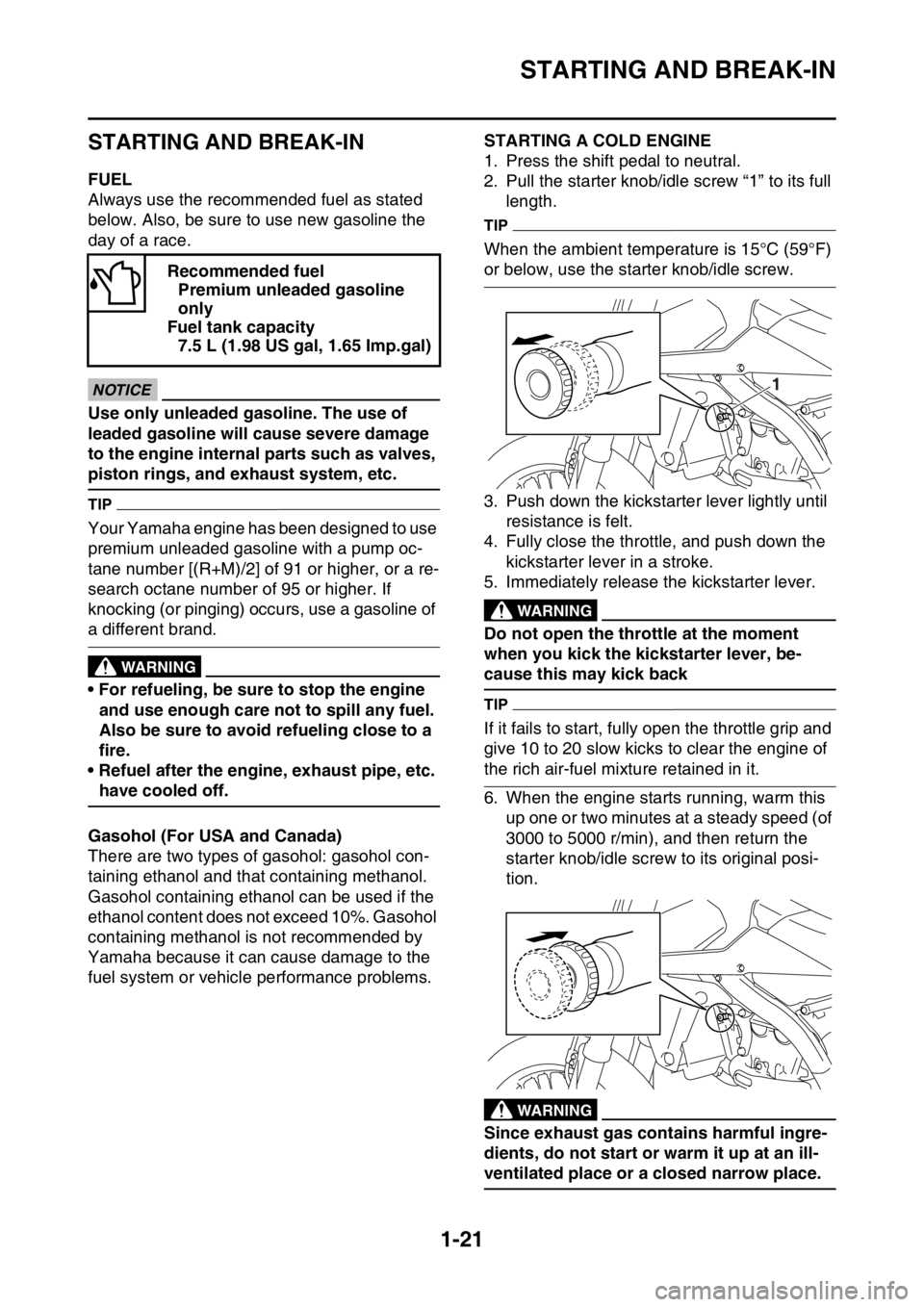length YAMAHA YZ450F 2016 Owners Manual
[x] Cancel search | Manufacturer: YAMAHA, Model Year: 2016, Model line: YZ450F, Model: YAMAHA YZ450F 2016Pages: 362, PDF Size: 10.49 MB
Page 7 of 362

EASB111005
SAFETY INFORMATION
THIS MACHINE IS DESIGNED STRICTLY FOR COMPETITION USE, ONLY ON A CLOSED
COURSE. It is illegal for this machine to be operated on any public street, road, or highway. Off-road
use on public lands may also be illegal. Please check local regulations before riding.
• THIS MACHINE IS TO BE OPERATED BY AN EXPERIENCED RIDER ONLY.
Do not attempt to operate this machine at maximum power until you are totally familiar with its char-
acteristics.
• THIS MACHINE IS DESIGNED TO BE RIDDEN BY THE OPERATOR ONLY.
Do not carry passengers on this machine.
• ALWAYS WEAR PROTECTIVE APPAREL.
When operating this machine, always wear an approved helmet with goggles or a face shield. Also
wear heavy boots, gloves, and protective clothing. Always wear proper fitting clothing that will not
be caught in any of the moving parts or controls of the machine.
• ALWAYS MAINTAIN YOUR MACHINE IN PROPER WORKING ORDER.
For safety and reliability, the machine must be properly maintained. Always perform the pre-oper-
ation checks indicated in this manual.
Correcting a mechanical problem before you ride may prevent an accident.
• GASOLINE IS HIGHLY FLAMMABLE.
Always turn off the engine while refueling. Take care to not spill any gasoline on the engine or ex-
haust system. Never refuel in the vicinity of an open flame, or while smoking.
• GASOLINE CAN CAUSE INJURY.
If you should swallow some gasoline, inhale excess gasoline vapors, or allow any gasoline to get
into your eyes, contact a doctor immediately. If any gasoline spills onto your skin or clothing, imme-
diately wash skin areas with soap and water, and change your clothes.
• ONLY OPERATE THE MACHINE IN AN AREA WITH ADEQUATE VENTILATION.
Never start the engine or let it run for any length of time in an enclosed area. Exhaust fumes are
poisonous. These fumes contain carbon monoxide, which by itself is odorless and colorless. Car-
bon monoxide is a dangerous gas which can cause unconsciousness or can be lethal.
• PARK THE MACHINE CAREFULLY; TURN OFF THE ENGINE.
Always turn off the engine if you are going to leave the machine. Do not park the machine on a slope
or soft ground as it may fall over.
• THE ENGINE, EXHAUST PIPE AND MUFFLER WILL BE VERY HOT AFTER THE ENGINE HAS
BEEN RUN.
Be careful not to touch them or to allow any clothing item to contact them during inspection or repair.
• PROPERLY SECURE THE MACHINE BEFORE TRANSPORTING IT.
For safety, drain the gasoline from the fuel tank before transporting the vehicle.
Page 35 of 362

STARTING AND BREAK-IN
1-21
EASB111040
STARTING AND BREAK-IN
EASB111041FUEL
Always use the recommended fuel as stated
below. Also, be sure to use new gasoline the
day of a race.
ECA
NOTICE
Use only unleaded gasoline. The use of
leaded gasoline will cause severe damage
to the engine internal parts such as valves,
piston rings, and exhaust system, etc.
TIP
Your Yamaha engine has been designed to use
premium unleaded gasoline with a pump oc-
tane number [(R+M)/2] of 91 or higher, or a re-
search octane number of 95 or higher. If
knocking (or pinging) occurs, use a gasoline of
a different brand.
EWA
WARNING
• For refueling, be sure to stop the engine
and use enough care not to spill any fuel.
Also be sure to avoid refueling close to a
fire.
• Refuel after the engine, exhaust pipe, etc.
have cooled off.
Gasohol (For USA and Canada)
There are two types of gasohol: gasohol con-
taining ethanol and that containing methanol.
Gasohol containing ethanol can be used if the
ethanol content does not exceed 10%. Gasohol
containing methanol is not recommended by
Yamaha because it can cause damage to the
fuel system or vehicle performance problems.
EASB111042STARTING A COLD ENGINE
1. Press the shift pedal to neutral.
2. Pull the starter knob/idle screw “1” to its full
length.
TIP
When the ambient temperature is 15°C (59°F)
or below, use the starter knob/idle screw.
3. Push down the kickstarter lever lightly until
resistance is felt.
4. Fully close the throttle, and push down the
kickstarter lever in a stroke.
5. Immediately release the kickstarter lever.
EWA
WARNING
Do not open the throttle at the moment
when you kick the kickstarter lever, be-
cause this may kick back
TIP
If it fails to start, fully open the throttle grip and
give 10 to 20 slow kicks to clear the engine of
the rich air-fuel mixture retained in it.
6. When the engine starts running, warm this
up one or two minutes at a steady speed (of
3000 to 5000 r/min), and then return the
starter knob/idle screw to its original posi-
tion.
EWA
WARNING
Since exhaust gas contains harmful ingre-
dients, do not start or warm it up at an ill-
ventilated place or a closed narrow place. Recommended fuel
Premium unleaded gasoline
only
Fuel tank capacity
7.5 L (1.98 US gal, 1.65 Imp.gal)
1
Page 42 of 362

GENERAL SPECIFICATIONS
2-1
EASB111051
GENERAL SPECIFICATIONS
Model
Model B111, B115 (USA) (CAN)
B112, B116 (EUR)
B113 (JPN)
B114, B117 (AUS) (NZL) (ZAF)
Dimensions
Overall length 2180 mm (85.8 in)
Overall width 825 mm (32.5 in)
Overall height 1280 mm (50.4 in)
Seat height 965 mm (38.0 in)
Wheelbase 1480 mm (58.3 in)
Ground clearance 330 mm (13.0 in)
Weight
Curb weight 112 kg (247 lb)
Page 45 of 362

ENGINE SPECIFICATIONS
2-4
Valve spring
Free length (intake) 40.76 mm (1.60 in)
Limit 38.72 mm (1.52 in)
Free length (exhaust) 36.94 mm (1.45 in)
Limit 35.09 mm (1.38 in)
Installed length (intake) 34.78 mm (1.37 in)
Installed length (exhaust) 30.83 mm (1.21 in)
Spring rate K1 (intake) 31.90 N/mm (3.25 kgf/mm, 182.15 lbf/in)
Spring rate K2 (intake) 41.37 N/mm (4.22 kgf/mm, 236.22 lbf/in)
Spring rate K1 (exhaust) 21.76 N/mm (2.22 kgf/mm, 124.25 lbf/in)
Spring rate K2 (exhaust) 28.12 N/mm (2.87 kgf/mm, 160.57 lbf/in)
Installed compression spring force (intake) 178.00–204.00 N (18.15–20.80 kgf,
40.01–45.86 lbf)
Installed compression spring force (exhaust) 124.00–142.00 N (12.64–14.48 kgf,
27.88–31.92 lbf)
Spring tilt (intake) 2.5 °/1.8 mm (2.5 °/0.07 in)
Spring tilt (exhaust) 2.5 °/1.6 mm (2.5 °/0.06 in)
Winding direction (intake) Clockwise
Winding direction (exhaust) Clockwise
Cylinder
Bore 97.000–97.010 mm (3.8189–3.8193 in)
Taper limit 0.050 mm (0.0020 in)
Out of round limit 0.050 mm (0.0020 in)
Piston
Piston-to-cylinder clearance 0.030–0.055 mm (0.0012–0.0022 in)
Limit 0.15 mm (0.006 in)
Diameter 96.955–96.970 mm (3.8171–3.8177 in)
Measuring point (from piston skirt bottom) 9.0 mm (0.35 in)
Offset 0.00 mm (0.0000 in)
Piston pin bore inside diameter 18.004–18.015 mm (0.7088–0.7093 in)
Limit 18.045 mm (0.7104 in)
Piston pin outside diameter 17.991–18.000 mm (0.7083–0.7087 in)
Limit 17.971 mm (0.7075 in)
Piston ring
Top ring
Ring type Barrel
Dimensions (B T) 1.00 3.30 mm (0.04 0.13 in)
End gap (installed) 0.20–0.30 mm (0.0079–0.0118 in)
Limit 0.55 mm (0.0217 in)
Ring side clearance 0.015–0.065 mm (0.0006–0.0026 in)
Limit 0.120 mm (0.0047 in)
2nd ring
Ring type Taper
Dimensions (B T) 1.00 3.10 mm (0.04 0.12 in)
End gap (installed) 0.35–0.50 mm (0.0138–0.0197 in)
Limit 0.85 mm (0.0335 in)
Ring side clearance 0.020–0.060 mm (0.0008–0.0024 in)
Limit 0.120 mm (0.0047 in)
Oil ring
Dimensions (B T) 1.50 2.55 mm (0.06 0.10 in)
End gap (installed) 0.20–0.50 mm (0.0079–0.0197 in)
Page 46 of 362

ENGINE SPECIFICATIONS
2-5
Crankshaft
Crank assembly width 61.95–62.00 mm (2.439–2.441 in)
Runout limit 0.030 mm (0.0012 in)
Big end side clearance 0.150–0.450 mm (0.0059–0.0177 in)
Balancer
Balancer drive method Gear
Clutch
Clutch type Wet, multiple-disc
Clutch release method Inner push, cam push
Clutch lever free play 7.0–12.0 mm (0.28–0.47 in)
Friction plate thickness 2.92–3.08 mm (0.115–0.121 in)
Wear limit 2.85 mm (0.112 in)
Plate quantity 8 pcs
Clutch plate thickness 1.50–1.70 mm (0.059–0.067 in)
Plate quantity 7 pcs
Warpage limit 0.10 mm (0.0039 in)
Clutch spring free length 48.00 mm (1.89 in)
Limit 45.60 mm (1.80 in)
Spring quantity 6 pcs
Push rod bending limit 0.10 mm (0.0039 in)
Transmission
Transmission type Constant mesh 5-speed
Primary reduction system Spur gear
Primary reduction ratio 2.609 (60/23)
Final drive Chain
Secondary reduction ratio 3.692 (48/13)
Operation Left foot operation
Gear ratio
1st 1.929 (27/14)
2nd 1.533 (23/15)
3rd 1.300 (26/20)
4th 1.091 (24/22)
5th 0.952 (20/21)
Main axle runout limit 0.08 mm (0.0032 in)
Drive axle runout limit 0.08 mm (0.0032 in)
Shifting mechanism
Shift mechanism type Shift drum and guide bar
Shift fork guide bar bending limit 0.050 mm (0.0020 in)
Shift fork thickness 4.85 mm (0.1909 in)
Decompression device
Device type Auto decomp
Air filter
Air filter element Wet element
Air filter oil grade Foam air-filter oil
Fuel pump
Pump type Electrical
Fuel injector
Model/quantity 1010/1
Resistance 12.0
Page 49 of 362

CHASSIS SPECIFICATIONS
2-8
Front brake
Type Single disc brake
Operation Right hand operation
Front disc brake
Disc outside diameter thickness 270 3.0 mm (10.6 0.12 in)
Brake disc thickness limit 2.5 mm (0.10 in)
Brake pad lining thickness (inner) 4.4 mm (0.17 in)
Limit 1.0 mm (0.04 in)
Brake pad lining thickness (outer) 4.4 mm (0.17 in)
Limit 1.0 mm (0.04 in)
Master cylinder inside diameter 9.52 mm (0.37 in)
Caliper cylinder inside diameter 22.65 mm 2 (0.89 in 2)
Specified brake fluid DOT 4
Rear brake
Type Single disc brake
Operation Right foot operation
Brake pedal position 0.0 mm (0.00 in)
Rear disc brake
Disc outside diameter thickness 245 4.0 mm (9.6 0.16 in)
Brake disc thickness limit 3.5 mm (0.14 in)
Brake disc runout limit (as measured on wheel) 0.15 mm (0.0059 in)
Brake pad lining thickness (inner) 6.4 mm (0.25 in)
Limit 1.0 mm (0.04 in)
Brake pad lining thickness (outer) 6.4 mm (0.25 in)
Limit 1.0 mm (0.04 in)
Master cylinder inside diameter 11.0 mm (0.43 in)
Caliper cylinder inside diameter 25.40 mm 1 (1.00 in 1)
Specified brake fluid DOT 4
Steering
Steering bearing type Taper roller bearing
Center to lock angle (left) 43.0 °
Center to lock angle (right) 43.0 °
Front suspension
Type Telescopic fork
Spring/shock absorber type Coil spring/oil damper
Front fork travel 310.0 mm (12.20 in)
Fork spring free length 497.0 mm (19.57 in)
Limit 492.0 mm (19.37 in)
Installed length 497.0 mm (19.57 in)
Spring rate K1 5.00 N/mm (0.51 kgf/mm, 28.55 lbf/in) (USA)
(CAN)
4.90 N/mm (0.50 kgf/mm, 27.98 lbf/in) (EUR)
(JPN) (AUS) (NZL) (ZAF)
Spring stroke K1 0.0–310.0 mm (0.00–12.20 in)
Inner tube outer diameter 48 mm (1.9 in)
Inner tube bending limit 0.2 mm (0.01 in)
Optional spring available Yes
Recommended oil Suspension oil S1
Quantity 511.0 cm
3 (17.28 US.oz, 18.02 Imp.oz)
Page 50 of 362

CHASSIS SPECIFICATIONS
2-9
Rebound damping adjusting positions
Minimum 20 clicks out*
Standard 11 clicks out*
Maximum Fully turned in
*With the adjuster fully turned in
Compression damping adjusting positions
Minimum 20 clicks out*
Standard 8 clicks out* (USA) (CAN)
16 clicks out* (EUR) (JPN) (AUS) (NZL) (ZAF)
Maximum Fully turned in
*With the adjuster fully turned in
Rear suspension
Type Swingarm (link suspension)
Spring/shock absorber type Coil spring/gas-oil damper
Rear shock absorber assembly travel 132.0 mm (5.20 in)
Spring free length 275.0 mm (10.83 in)
Spring rate K1 56.00 N/mm (5.71 kgf/mm, 319.76 lbf/in)
Spring stroke K1 0.0–150.0 mm (0.00–5.91 in)
Optional spring available Yes
Enclosed gas/air pressure (STD) 980 kPa (9.8 kgf/cm
2, 139.4 psi)
Spring preload adjusting positions
Minimum Position in which the spring is turned in 1.5 mm
(0.06 in) from its free length.
Standard Position in which the spring is turned in 10 mm
(0.39 in) from its free length.
Maximum Position in which the spring is turned in 18 mm
(0.71 in) from its free length.
Rebound damping adjusting positions
Minimum 30 clicks out*
Standard 14 clicks out* (USA) (CAN)
12 clicks out* (EUR) (JPN) (AUS) (NZL) (ZAF)
Maximum Fully turned in
*With the adjuster fully turned in
Compression damping setting
(for fast compression damping)
Minimum 2 turns out*
Standard 1-1/4 turns out* (USA) (CAN)
1-3/8 turns out* (EUR) (JPN) (AUS) (NZL)
(ZAF)
Maximum Fully turned in
*With the adjuster fully turned in
Compression damping setting
(for slow compression damping)
Minimum 20 clicks out*
Standard 10 clicks out* (USA) (CAN)
12 clicks out* (EUR) (JPN) (AUS) (NZL) (ZAF)
Maximum Fully turned in
*With the adjuster fully turned in
Page 51 of 362

CHASSIS SPECIFICATIONS
2-10
Swingarm
Swingarm end free play limit (radial) 1.0 mm (0.04 in)
Swingarm end free play limit (axial) 0.2–0.9 mm (0.01–0.04 in)
Drive chain
Size/manufacturer 520DMA2-SDH/DAIDO
Number of links 114
Drive chain slack 50–60 mm (1.97–2.36 in)
15-link length limit 242.9 mm (9.56 in)
Page 85 of 362

MAINTENANCE INTERVALS
3-1
EASB111064
MAINTENANCE INTERVALS
EASB111065MAINTENANCE INTERVALSECA@
NOTICE
• After a break-in or before each race, always check the points shown in “TORQUE-CHECK
POINTS” for tightening torques and retighten them. (“TORQUE-CHECK POINTS” on page 1-
24.)
• Periodic inspection is essential in making full use of the machine performance. The life of
parts varies significantly according to the environment in which the machine runs (e.g., rain,
dirt, etc.). Therefore, earlier inspection is required by reference to the list below.
ITEMAfter
break-
inEvery
race
(about
2.5
hours)Every
third
(about
7.5
hours)Every
fifth
(about
12.5
hours)As re-
quiredRemarks
VALVE
Check the valve
clearancesThe engine must be cold.
Inspect Check the valve seats and the
valve faces for wear.
Replace
VALVE SPRING
Inspect Check the free length and the
tilt.
Replace
VALVE LIFTER
Inspect Check for scratches and wear.
Replace
CAMSHAFT Inspect the camshaft surface.
Inspect Inspect the decompression
system.
Replace
CAMSHAFT
SPROCKET
Inspect Check for wear on the teeth
and for damage.
Replace
PISTON
Inspect Inspect crack.
Clean Inspect carbon deposits and
eliminate them.
Replace Replace the piston, piston pin,
piston pin clip, and piston ring
all as a set.
Page 106 of 362

CHASSIS
3-22
EASB111088
CHASSIS
EASB111089BLEEDING THE BRAKE SYSTEMEWA13100
WARNING
Bleed the brake system whenever:
• The system is disassembled.
• A brake hose is loosened, disconnected,
or replaced.
• The brake fluid level is very low.
• Brake operation is faulty.
1. Remove:
• Brake master cylinder cap
• Reservoir diaphragm
• Reservoir float (front brake)
• Protector (rear brake)
TIP
• Be careful not to spill any brake fluid or allow
the reservoir to overflow.
• Make sure that there is enough brake fluid be-
fore applying the brake. Ignoring this precau-
tion could allow air to enter the brake system,
considerably lengthening the bleeding proce-
dure.
• If bleeding is difficult, it may be necessary to
let the brake fluid settle for a few hours. Re-
peat the bleeding procedure when the tiny
bubbles in the hose have disappeared.
2. Bleed the brake system.
▼▼▼▼▼▼▼▼▼▼▼▼▼▼▼▼▼▼▼▼▼▼▼▼▼▼▼▼▼▼▼▼
a. Fill the reservoir to the proper level with the
recommended brake fluid.
b. Install the reservoir diaphragm.
c. Connect the plastic hose “1” to the bleed
screw “2” securely, and place a container
under the end of the plastic hose.d. Slowly apply the brake several times.
e. Fully pull the brake lever or fully press down
the brake pedal and hold it in position.
f. Loosen the bleed screw.
TIP
Loosening the bleed screw will release the
pressure in the brake caliper and cause the
brake lever to contact the throttle grip or the
brake pedal to fully extend.
g. Tighten the bleed screw and then release
the brake lever or brake pedal.
h. Repeat steps (d) to (g) until all of the air bub-
bles have disappeared from the brake fluid
in the plastic hose.
TIP
During the procedure, keep adding brake fluid
to the reservoir.
ECA
NOTICE
Brake fluid may erode painted surfaces or
plastic parts. Always clean up spilled fluid
immediately.
i. Tighten the bleed screw.
j. Pour brake fluid to the reservoir up to the
specified level.
Refer to “CHECKING THE BRAKE FLUID
LEVEL” on page 3-27.
EWA13110
WARNING
After bleeding the hydraulic brake system,
check the brake operation.
▲▲▲▲▲▲▲▲▲▲▲▲▲▲▲▲▲▲▲▲▲▲▲▲▲▲▲▲▲▲▲▲
1 2
A
A. Front
B. Rear
Bleed screw
6 Nm (0.6 m·kgf, 4.3 ft·lbf)
2
1B
T R..